Dan Dan Noodles are a spicy, savory, nutty flavor bomb, SO craveable, and easy to make at home!
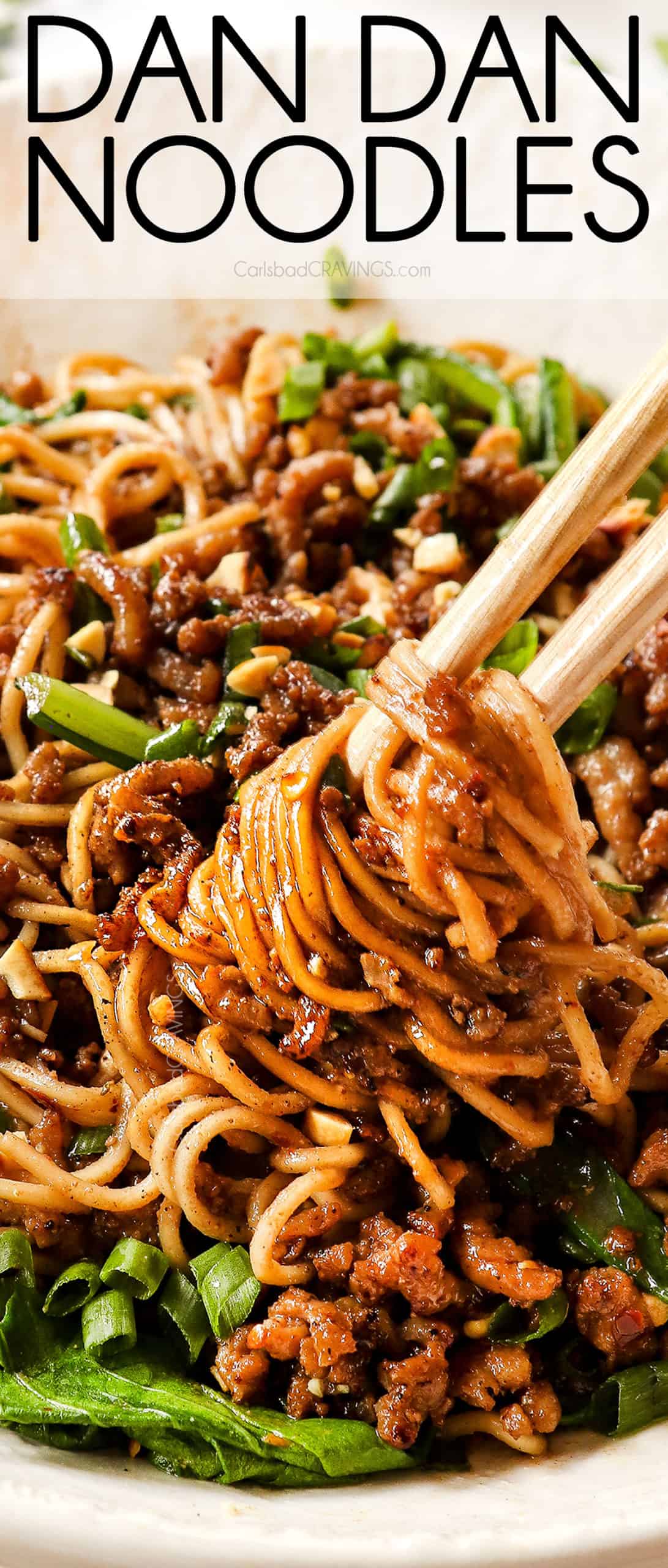
This Dan Dan Noodle recipe packs a fiery, nutty, aromatic punch you will CRAVE plus you can easily adjust the heat level to suit your own tastes. These explosive noodles are made of fresh, thin noodles layered in an intense savory, smoky, spicy, numbing, sesame chili sauce laced with Chinese 5 spice and Sichuan peppercorns, then topped with crispy ground pork, green onions and chopped peanuts. The layers get stirred together to create the iconic slippery Sichuan noodles we all know and love. This Dan Dan Noodle recipe stays true to the authentic Sichuan flavor and details all the key ingredients but still offers plenty of pantry friendly substitutions. The ingredient list will look long, but there is hardly any chopping and less than 10 minutes of cook time – most of the ingredients are just whisked together, which means this recipe is a cinch and on your table in less than 30 minutes once you gather your ingredients!
If you are a lover of Asian noodles, I’ve got you covered! Feast on: Sesame Noodles, Singapore Noodles, Korean Spicy Noodles, Honey Sriracha Noodles, Chicken Yakisoba, Vietnamese Noodles, Red Curry Coconut Rice Noodles, Pad Sew Ew, Pad Thai, Spicy Ramen and Pork Ramen.
PIN THIS RECIPE TO SAVE FOR LATER
What Are Dan Dan Noodles?
If you’ve never tried Dan Dan Noodles (担担面, dan dan mian) before, it’s your lucky day! These spicy, smoky, numbing, mega flavorful noodles are a popular Szechuan street food made from fresh thin wheat noodles, chili oil, Szechuan pepper, sesame paste, savory ground pork and fermented vegetables (don’t worry, so good!).
In China, Dan Dan Noodles can be more saucy or soupy, but always numbingly spicy. In the US, the Chinese noodles have evolved to resemble more of a pasta dish with a lighter sauce. The sauce is spooned into the bottom of a bowl then layered with the rest of the ingredients before being stirred together with chopsticks to coat everything in a thin layer of sauce before eating.
Dan Dan Noodles are typically eye wateringly spicy but you can completely customize the spice level by adding more or less chili oil. My recipe is ultra flavorful and definitely spicy, but you will still be able to feel your tongue afterwards 😉.
What do Dan Dan noodles taste like?
Dan Dan Noodles boast chewy, round, medium thin wheat noodles, coated in an intense, spicy, nutty, and savory sauce, thanks to ingredients like black vinegar and crushed peanuts. Sichuan peppercorns cause a tingling, numbing sensation, while scallions and garlic add punchy aromatic fragrance and pickled mustard greens lend a sour, tangy depth. The dish is finished with crispy ground pork which is savory garnish, rather than the star attraction.
What does Dan Dan Noodles mean? History of Dan Dan Noodles
Dan Dan Noodles translates directly to “noodles carried on a pole,” but more accurately means “peddler’s noodles.” The name refers to a long bamboo pole called a dan dan that was once carried over the shoulders of walking street venders in Chengdu. The vendors would tie baskets at the end of the pole and fill them with the sauce, noodles and pork topping to make Dan Dan Noodles, so as soon as they made a sale, they could stop and quickly whip up a batch of fresh noodles. Today, Dan Dan Noodles are not just a Sichuan street food, but a popular Chinese noodle dish all around the world.
These Dandan Noodles are fabulous
I’m not going to call this an 100% authentic Dan Dan Noodle recipe, but I will call it 100% fabulous. As with all of my recipes, I conducted extensive research and taste tests to come up with this winning Dan Dan Noodle recipe. With this recipe, you’ll get the key, alluring, distinctive factors of umami, smoky, spicy, numbing, nutty, and sour.
However, Sichuan Dan Dan Noodles are one of those recipes that contain innumerable variations. Authentic Dan Dan Noodles are spicy and numbing (caused by Sichuan peppercorns), but in Chinese restaurants, they can range from spicy to less spicy, to more sweet and sour, to more nutty. It seems everyone has their own version of what Dan Dan Noodles should be, so I’m giving you a springboard to make them YOUR perfect Dan Dan Noodle recipe.
The complex array of flavors that defines Dan Dan Noodles requires many different ingredients including chili oil, ground Sichuan peppercorns, crispy pork and pickled mustard greens. As such, the ingredients list is lengthy, but the recipe itself doesn’t require much time or effort to make – there is hardly any chopping, only whisking ingredients together – and less than 10 minutes on the stove!
This recipe introduces a few new ingredients, but trust me, you can get them online (links included) or at an Asian market, and once you have them stocked, making these Chinese Noodles are super straight forward. So, please don’t be intimidated or skip this recipe or you’ll be skipping out on some major YUM! You’re just a couple whisks and a stir fry away from some of the best Chinese Noodles you’ve slurped in your entire life!

How to Assemble Dan Dan Noodles
Dan Dan Noodles are so fabulous because they are so flavorful! This is achieved by layering flavors and textures of four main components: 1) the Dan Dan sauce, 2) the noodles and leafy greens, 3) the spiced pork and the fermented veggies, and 4) the peanuts and green onions. Unlike most Chinese noodles, the ingredients are layered in serving bowls before being tossed together.
I want to first illustrate how Dan Dan Noodles are assembled so you’ll know where the different components fit in, then I’ll break down the components/ingredients and how to make the recipe in further detail below:
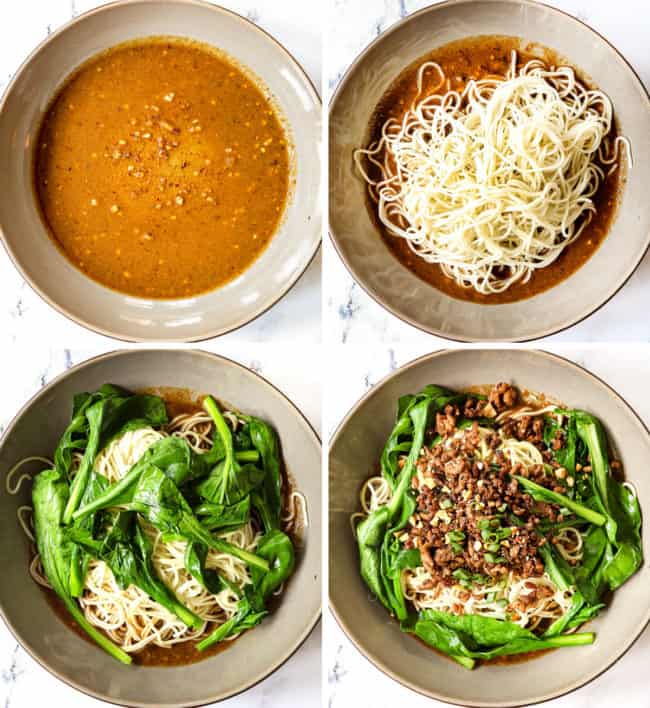
- First – Dan Dan Sauce: This is a numbing, savory, slightly nutty sauce made of chili oil, ground Sichuan pepper, Chinese 5 spice, soy sauce, chicken broth, and rice vinegar. The oil is made separately (or you can use store bought), then whisked into the ingredients to deliver the signature numbing, hot, sleek noodles. The sauce gets divided between four bowls.
- Second – Noodles and Greens: Fresh noodles are cooked for 45 seconds or so along with leafy greens that get blanched in the same water. They are laid on top of the sauce but not mixed in yet.
- Third – Cooked Toppings: These consist of pork cooked and seasoned with hoisin, rice wine and soy sauce, preserved mustard greens (sui mi ya cai) that get briefly warmed in a skillet for 30 seconds or so.
- Fourth – Fresh Toppings: These consist of green onions and chopped peanuts.
- Fifth – Stir and Eat: Serve the Dan Dan Noodles in this layered mountain and allow everyone to give them a stir with chopsticks until everything is well coated in sauce, then dig in!
What you’ll need for this Dan Dan Noodles Recipe
I’m going to detail the more authentic way to make Dan Dan Noodles, but also offer plenty of pantry substitutes so you can make this recipe without a special trip to the Asian market.
PART 1: THE CHILI OIL
You can’t make Dan Dan Noodles without chili oil! The oil is mixed into the Dan Dan Sauce (more on that below) and infuses the noodles with heat and aromatic smokiness. Homemade chili oil is easy to make at home with just a few ingredients and a few minutes or you can purchase Chinese chili oil at any Asian grocery store, just make sure to look for oil with actual red pepper flakes in it. I particularly like Blank Slate Kitchen Sichuan Chili Oil.
Please note that Chinese chili oil is not the same as chili sauce or paste. If you are substituting with chili sauce, you will want to mix 1-part chili sauce to 2 parts oil.
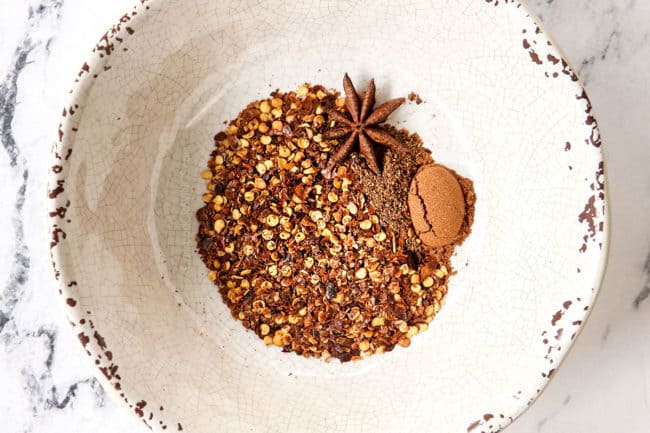
Here’s what you’ll need to make homemade chili oil:
- Oil: We will use vegetable oil as the neutral base then add a couple tablespoons toasted sesame oil for a punch of flavor.
- Red chili flakes: Brings the heat!
- Chinese five spice powder: Is easy to find at most grocery stores or on Amazon. It is thought to have come from ancient Chinese who were attempting to produce a “wonder powder” that encompasses all five tastes: sweet, sour, bitter, salty and a spicy. They did this by combining Szechuan peppercorns, ground cloves, fennel, cinnamon, star anise and cinnamon. In other words, it’s a taste bud wonder!
- Szechuan peppercorn powder: Is an essential ingredient to making Dan Dan Noodles at home, so don’t omit it. Szechuan peppercorn adds peppery, numbing (not fiery) heat and complex citrus notes that is hard to replicate. I prefer Szechuan peppercorn powder because it is easy to use and save you a tedious step. Szechuan peppercorn can be found on Amazon at most Asian markets (call first) spice stores, or sometimes specialty stores like Whole Foods and Sprouts. The most important thing to be aware of is that Szechuan Peppercorn can be sold under different names: dried peppercorn, dried prickly ash, dehydrated prickly ash, Indonesian lemon pepper, flower pepper, or hua jiao.
What are Szechuan Peppercorn?
Szechuan peppercorn (“peppercorn” is the correct plural form) are actually a berry from the husks of Chinese Ash trees in the citrus family. It actually doesn’t come from the same family as black pepper nor is it related to chili peppers. Instead, it is its own fabulous entity.
Szechuan peppercorn actually aren’t spicier than black peppercorn, but they do boast a more complex flavor. Szechuan peppercorn taste perfumy, complex, and peppery with a citrus zing and pine, lavender notes coupled with a tangible mouth-numbing sensation. They remind me of a complex cross between pepper, cardamom, ginger, clove and lemon.
Why do Szechuan Peppercorn make your mouth numb?
This tingling sensation is caused by the molecule hydroxy-alpha-sanshool in the peppercorn that interacts with the nerve cell receptors in your lips and mouth – but don’t be alarmed! The molecule is simply telling the brain that the area is being touched and the brain confuses this with sensation of numbness. Chefs speculate that the numbing effect takes down the heat of the accompanying chilies, which allows partakers to more fully appreciate the chili’s fruity side – and not just the heat – another win for the Szechuan peppercorn!
Szechuan Peppercorn substitute
You can use a Szechuan peppercorn substitute if don’t have access to it but the Dana Dan Noodles will be lacking the unique, complex, flavor notes. There are many substitutes such as grains of paradise, Tellicherry peppercorns and Tasmanian pepper but the most accessible is freshly ground pepper and coriander.
White pepper + Coriander: The white pepper brings the peppery heat and the coriander brings the fresh, pungent citrus flavor.
PART 2: DAN DAN SAUCE
Dan Dan Sauce is mixed with the chili oil and added to the bottom of the serving bowl before the noodles. It permeates the entire dish with its hot, fiery tangy heat. The sauce is not cooked, so it’s super easy to make by whisking the ingredients together in a bowl, even though there’s quite a few 😉. Here’s what you’ll need:
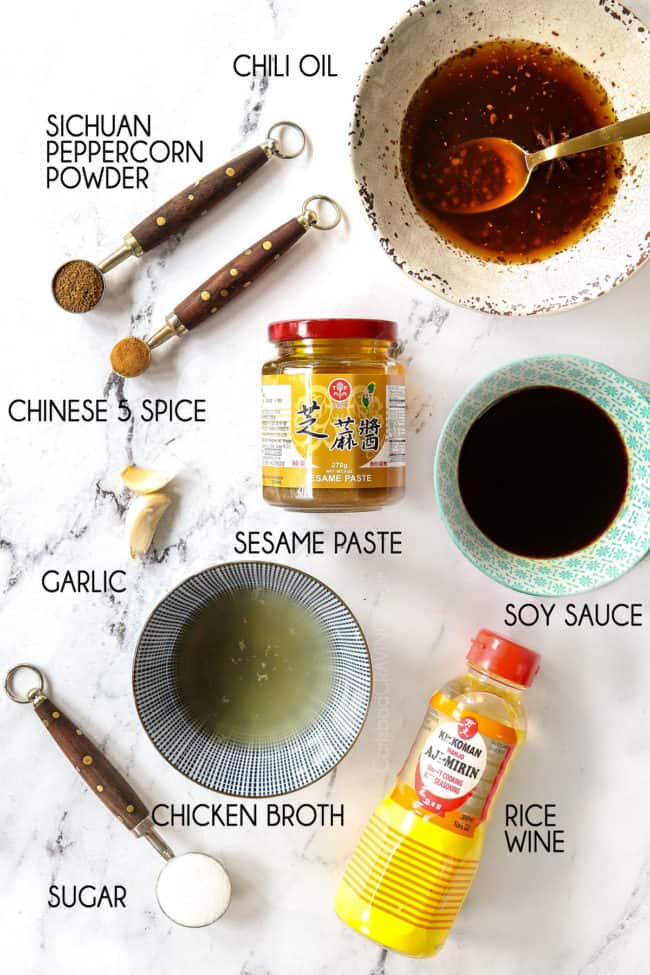
- Chili oil: Homemade from above or store-bought or purchased on Amazon.
- Soy sauce: Use reduced sodium soy sauce or your Dan Dan sauce will be too salty.
- Chicken broth: Creates the base of the sauce. Again, use reduced sodium chicken broth so you can control the salt.
- Chinese sesame paste (芝麻酱, zhi ma jiang): Is a thick paste made from roasted white sesame seeds. It thickens the sauce and adds a deep, nutty, smoky flavor. It can be found in Asian markets or on Amazon. Please note that Chinese sesame paste is NOT sesame sauce or tahini. Chinese Sesame paste has the consistency of thick honey whereas sesame sauce is thinner and less robust. Sesame paste differs from tahini in that the sesame seeds in tahini are raw, hulled sesame seeds whereas the sesame seeds in sesame paste are toasted, whole sesame seeds, which actually makes a huge difference in flavor. Chinese sesame paste is smokier, nuttier and richer in flavor. The best substitute for Chinese sesame paste is peanut butter mixed with a few teaspoons of sesame oil.
- Rice wine: Can be found in the Asian aisle of the supermarket. Do NOT confuse rice wine with rice vinegar or rice wine vinegar. They look very similar, so it’s easy to confuse them. Rice wine adds a sweetness and depth of tangy flavor. I use “Kikkoman Aji-Mirin: Sweet Cooking Rice Seasoning” which is commonly found in the Asian section of most grocery stores or you can Amazon it. I highly suggest you google image before you head off to the grocery store so you know exactly what you are looking for. The best substitute for rice wine is dry sherry.
- Sugar: Just one tablespoon to balance the acidity and heat.
- Szechuan peppercorn powder: The same ingredient used in the chili oil. Szechuan peppercorns add the unique, complex flavor notes and the tingly sensation.
- Chinese five spice powder: The same ingredient used in the chili oil made of star anise, cloves, cinnamon, Szechuan pepper, and fennel seeds.
- Garlic and ginger: Add a warm, spicy, almost pepper taste. These aromatics awaken and elevate the entire Dan Aja Noodles recipe. I use freshly minced garlic in the sauce but you can also substitute the garlic with ½ teaspoon garlic powder. If using fresh garlic, make sure to finely minced because it’s not being cooked first. For this reason, I recommend using ground ginger instead of fresh ginger.
PART 3: The pork
The pork is cooked and seasoned in a wok/skillet until crispy followed by a brief warming of the pickled mustard greens (called sui mi ya cai):
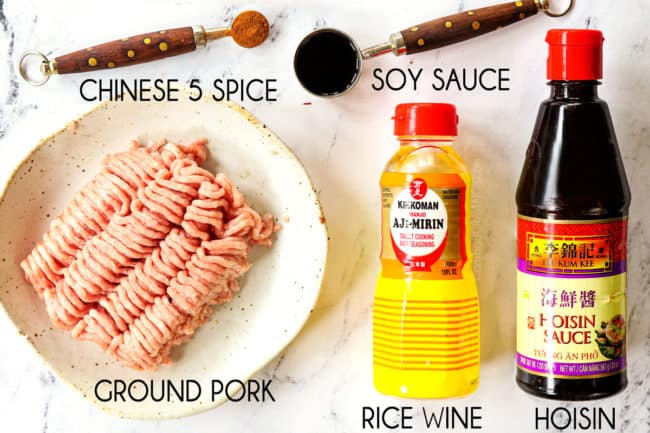
- Ground pork: is a crunchy, savory garnish, rather than the star attraction. Pork is the traditional protein used in Dan Dan Noodles because it browns nicely and quickly due to its fat to lean ratio and also crisps up beautifully. Using ground beef, ground turkey or ground chicken won’t give you the same flavor, but you may substitute ground beef in bind.
- Hoisin sauce: Can be found in the Asian section of any grocery store. It tastes like a sweet, salty and tangy, thick Asian BBQ Sauce. Use high quality hoisin sauce like Lee Kum Kee because you literally can TASTE the difference!
- Soy sauce, Rice Wine and Chinese 5 Spice: Are all used in the Dan Dan Sauce, so keep them out so they’re easy to access again to flavor the pork.
VEGETARIAN ALTERNATIVES
To make Dan Dan noodles vegetarian/vegan-friendly, you may substitute the pork with minced mushrooms or firm tofu. To prep the tofu, place it in a pie plate, top with a heavy plate and weigh down with 2 heavy cans (to release water). Set aside for 10 minutes before chopping and stir frying.
PART 4: THE FERMENTED MUSTARD GREENS (SUI MI YA CAI)
Fermented mustard greens (sui mi ya cai): are a type of cardamine bean sprout that is native to Sichuan, China that are dried, flavored with sugar and spices then fermented. They are a signature ingredient in Dan Dan Noodles and add an aromatic, slightly sweet, tangy, pungent, salty richness.
If your Asian market carries them, they will be in small plastic packages near the pickled items, but they will not be refrigerated. However, sui mi ya cai can be difficult to find, even at an Asian grocery store, so I suggest ordering them on Amazon here.
If you can’t find them Tianjin preserved vegetables, sold in squat jars at the Asian market, make a decent substitute or a mixture of kimchi and capers. If you don’t want to make a special trip to the market or order sui mi ya cai, you can skip them and your Chinese Noodles will still be tasty but they will be missing that complex layer of funk.

PART 5: The Noodles and leafy greens
The noodles and leafy green get cooked in the same pot for under a minute. You will need:

- Noodles: Dan Dan Noodles are usually made with round, medium thin wheat noodles, 1/8″ thick, not rice noodles. You can find semi-fresh wheat noodles in the refrigerated section at an Asian market, but they usually won’t be called out as Dan Dan Noodles. Instead, look for thin, white noodles and check the packaging to see if they’re made with wheat. If you can’t make it to the Asian market, any dry round, thin Asian wheat noodle will do, or substitute with linguine.
- Leafy greens: If you are making a trip to the Asian market, pick up a bunch choy sum (pictured here). The stalks are quite long, so I tend to cut them in half and use the top half of the leafy stalk. Otherwise, choy sum can easily be substituted with a bunch of spinach or bok choy. To use bok choy, use the top 6 inches and slice the stalks so they’re no larger than ½-inch.
- Garnish: Thinly sliced green onions and chopped peanuts are sprinkled on the Dan Dan Noodles very last. Purchase raw peanuts so they’re not overly salty then I suggest toasting them in the skillet first.
How to Make Dan Dan Noodles
Although the ingredients list is long, the recipe itself isn’t. Dan Dan Noodles come together quickly and are so easy to make! Here’s an overview of the cooking process:
Step 1: Make the chili oil
This step is optional if you are not using store-bought chili oil but encouraged if you don’t already have chili oil on hand because it’s SO EASY and uses ingredients you already need for the dish. The homemade chili oil can be made ahead of time and stored in an airtight containers in the refrigerator for up to 6 months.
To make the chili oil, add Chinese 5 spice, ground Szechuan peppercorn, red chili flakes and optional star anise to a heat proof bowl; set aside. Add the vegetable oil to a small saucepan and heat over medium heat for 2-3 minutes, until 325 degrees F. You don’t want to heat it any hotter or it will burn the spices upon contact. Next, very carefully pour the oil over the spices. Whisk in sesame oil; set aside.
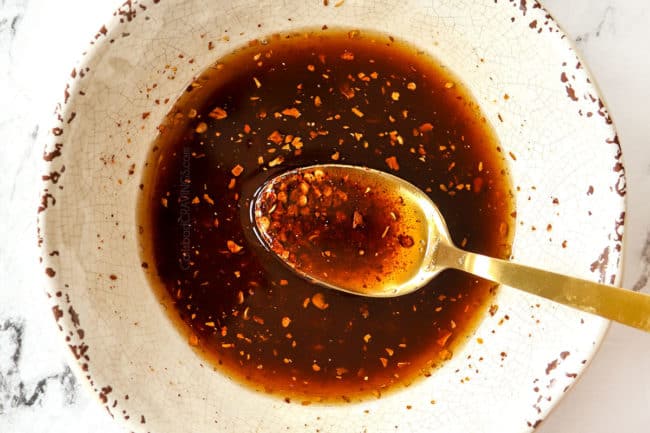
Step 2: Make the Dan Dan sauce
This section of ingredients is the longest, but it’s the easiest! Simply mix all of the Dan Dan Sauce ingredients together except the chili oil until smooth then whisk in 3-4 tablespoons chili oil.
You’ll want to make sure the chicken broth is warmed which will in turn warm the entire sauce and make it easier to whisk in the sesame paste. The sauce will seem thin but will thicken when mixed with the wheat noodles.
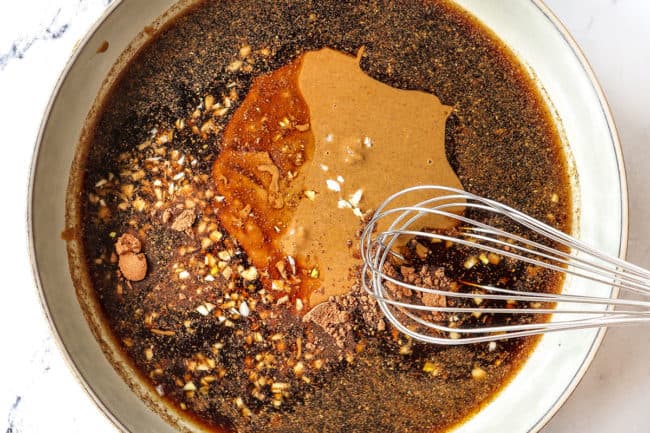
Step 3: Sear the Pork and warm sui mi ya cai
The key to crispy pork is to overcook the pork in a very hot wok or skillet. Cook the pork in hot oil, breaking up the pork as you go until it’s almost cooked through, then add the hoisin, soy sauce, rice vinegar and Chinese 5 spice and continue to cook for 1-2 minutes until the liquid is absorbed/evaporated. If the pork isn’t crispy at this point, increase heat to high and cook another minute or so; transfer to a bowl.
To the now empty skillet, add the sui mi ya cai and cook for just 30 seconds or so. You’re not looking to cook the greens, just warming them up.
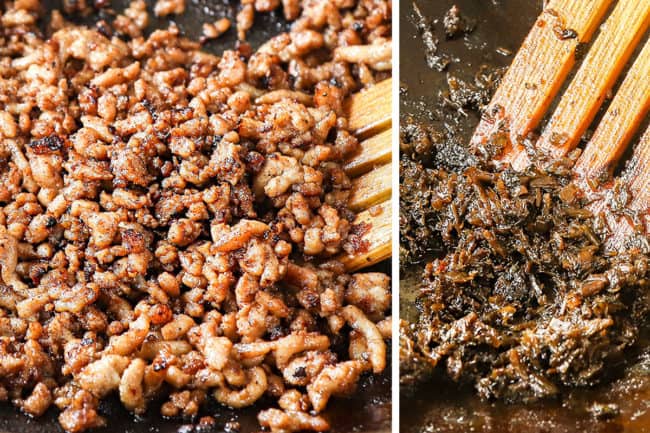
Step 4: Cook the Noodles and Blanch the Greens
If you’re using fresh noodles, they should only take about 45 seconds to cook, but make sure to cook according to package directions. If you’re not using fresh noodles, you’ll want to start cooking them earlier because they will take longer.
No matter which noodles you use, add the greens the last 30 seconds to simplify the cooking process. You can scoop out greens with a fine mesh sieve/strainer, then drain noodles to keep them separate or drain them all together. Toss the noodles with a drizzle of sesame oil to prevent them from sticking together.

Step 5: Assemble
Divide the Dan Dan sauce among four bowls. Top with noodles, choy sum (or leafy greens), pork, green onions and peanuts. Mix everything together until the noodles are well coated in the sauce. Add additional chili oil to taste if desired (taste first!).
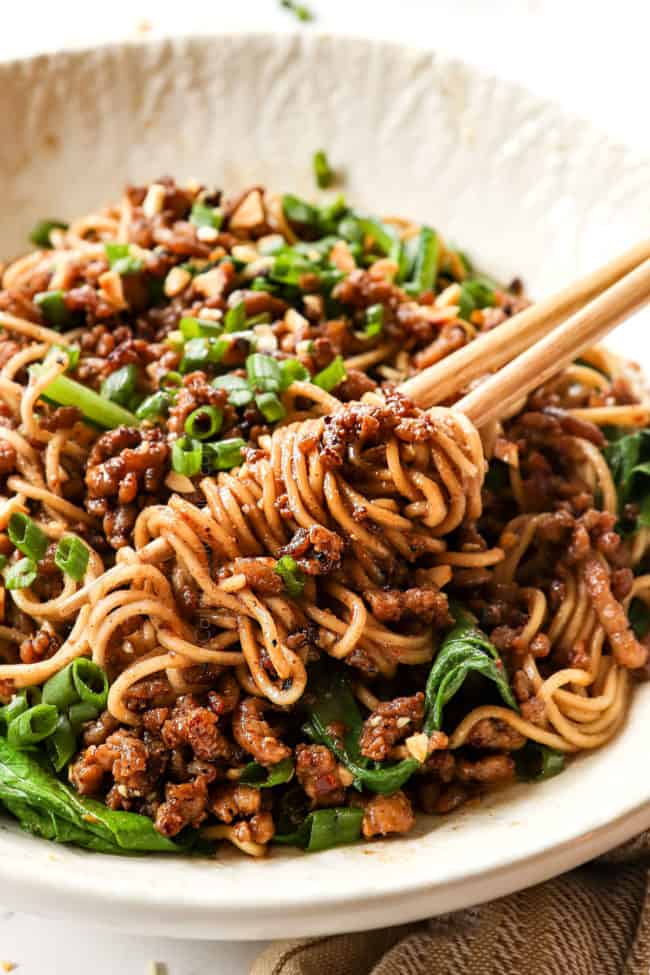
Dan Dan Mian tips
Here are just a few more tips and tricks for the best Dan Dan Noodles!
- Use the good stuff! This scrumptious Sichuan specialty contains some unique ingredients such as Sichuan peppercorn powder, Chinese Five Spice, Chinese sesame paste, and fermented mustard greens, but they are worth purchasing for these Sichuan Dan Dan Noodles! Plus, once you have them you can use them in Szechuan Chicken, Szechuan Beef, Chinese Chicken Wings, etc.
- Stir Chinese sesame paste: The oil will be separated from the thick paste underneath. You will need to stir the sesame paste thoroughly in the jar to incorporate the oil with the paste or you will only be getting thin oil and not the nutty richness. If the paste is full because it’s your first time using it, it may be easier to dump it all out into a larger bowl to stir instead of stirring in the jar.
- Pork is a garnish: The pork is supposed to be a topping, not the main attraction. If you would like more pork, you can double the pork and the pork ingredients.
- Prevent noodles from sticking: If you’re not ready to immediately assemble the bowls, then you’ll want to toss the noodles in a drizzle of sesame oil to prevent them from sticking together. If you don’t have sesame oil, use a neutral oil such as canola or vegetable oil.
- Customize heat: Dan Dan Noodles are meant to be spicy, but they don’t have to be fiery hot. I used 4 tablespoons chili oil and it was extremely spicy, even for me, and I like spicy, but they were still incredible. 3 tablespoons chili oil will probably be the perfect amount for those who like spicy but not as crazy spicy, 2 tablespoons chili oil for those who like spicy but are little hesitant. It is probably wise to start off with less chili oil in the Dan Dan Sauce then let individuals add more chili sauce to their individual bowls.
- Toast peanuts: Toasting the peanuts enhances their nutty flavor and makes them 10X better – and it’s easy. To dry roast peanuts, add ½ cup unsalted raw peanuts to a skillet over medium-high heat without any oil and toast, stirring occasionally, until golden in spots.
- Go low carb: To keep it low carb, try using shirataki noodles. Shirataki noodles are long, white noodles made from glucomannan, a type of fiber that comes from the root of the konjac plant. You can also use spiralized zucchini noodles.
Can I make this Dan Dan Mian in advance?
Dan Dan Noodles are best enjoyed after immediately assembled, but the components can be prepared in advance then warmed before using:
- Dan Dan sauce: Can be mixed together and stored in the fridge for up to one week. Omit the garlic and add just before serving or use garlic powder.
- Pork and preserved mustard greens: Can be stir fried 4 days ahead of time and stored in an airtight container in the refrigerator.
- Noodles: Can be cooked and tossed with sesame oil then stored in an airtight container for up to four days.
- Peanuts: Can be toasted, chopped and stored in an airtight container for up to one week before using.
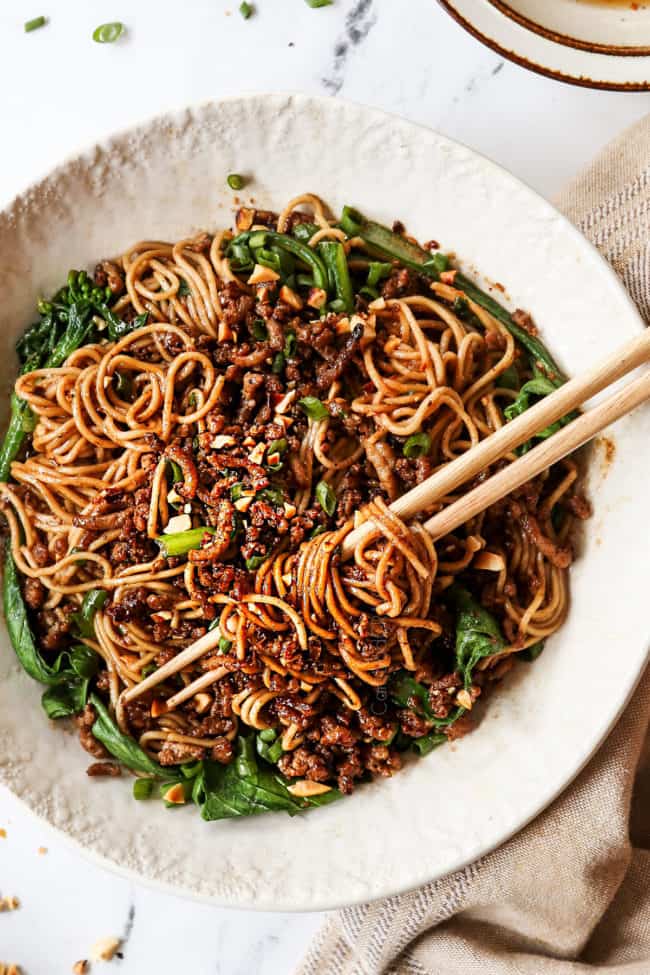
Dan Dan Noodle storage
- How to store: Store leftovers in an airtight container in the refrigerator for up to 5 days.
- How to reheat in the microwave: Transfer small portions to a microwave safe dish, heat for 1 minute, stir, then continue to heat at 20-second intervals as needed. You may need to toss the noodles with a drizzle of oil or chicken both to loosen the noodles.
- How to reheat on the stove: For larger portions, warm in a large skillet over medium-high heat, stirring often. You may need to toss with a drizzle of oil or chicken both to loosen the noodles.
Can You Freeze Dan Dan Noodles?
I do not recommend freezing the Dan Dan Noodles once assembled, however, you may freeze the pork and sauce separately:
- Sauce: Whisk together, add to a freezer bag or freezer-safe airtight container, label, and freeze for up to 3 months.
- Ground pork: Let cooked pork cool completely, then transfer to an airtight container or plastic freezer bag and squeeze out any excess air. Freeze for up to 3 months.
How to serve this Dan Dan Noodles Recipe
This Dan Dan Noodles recipe is explosively flavorful and bursting with protein, veggies and carbs. It’s a complete meal-in one! To turn it into a complete Asian feast, pair it with:
- Appetizers: Not all of these appetizers are Chinese, but they are all SO tasty! We love Dan Dan Noodles with Crab Rangoons, Pineapple Cream Cheese Wontons, Potstickers,Chicken Lettuce Wraps, Traditional Egg Rolls, Sesame Chicken Egg Rolls, Sweet and Sour Chicken Egg Rolls or Chinese Chicken Wings.
- Salad: Crunchy Asian Salad, Chinese Salad, and Asian Pineapple Salad.
- Soups: Asian soups make a fantastic starter, such as Egg Drop Soup Hot and Sour Soup, Wonton Soup, or Miso Soup.
- Fruit: Perfect Fruit Salad or Pina Colada Fruit Salad.
How to eat Dan Dan Noodles
To eat Dandan noodles, begin by stirring the noodles, chili sauce, and garnishes of minced pork, pickled veggies, crushed peanuts, and green onions together. Pick up small portions of everything together with chopsticks and slurp! Savor the spiciness, nuttiness, and sour elements and repeat. Adjust to your liking, specifically adding additional chili oil if you like more heat.
Dan Dan Noodles FAQs
In Cantonese, Dan Dan noodles are known as “担担面” (daam daam meen) which translates to “carrying a pole” and refers to the traditional method of street vendors carrying the noodles and ingredients on a pole across their shoulders as they sold the dish. “Meen” means noodles. So, ” daam daam meen” essentially translates to “carrying a pole noodles” in Cantonese.
The noodles in Dan Dan Noodles are usually made with round, medium thin wheat noodles, 1/8″ thick, not rice noodles. You can find semi-fresh wheat noodles in the refrigerated section at an Asian market, but they usually won’t be called out as Dan Dan Noodles. Instead, look for thin, white noodles and check the packaging to see if they’re made with wheat. If you can’t make it to the Asian market, any dry round, thin Asian wheat noodle will do, or substitute with linguine.
This tingling sensation is caused by the molecule hydroxy-alpha-sanshool in the peppercorn that interacts with the nerve cell receptors in your lips and mouth – but don’t be alarmed! The molecule is simply telling the brain that the area is being touched and the brain confuses this with sensation of numbness. Chefs speculate that the numbing effect takes down the heat of the accompanying chilies, which allows partakers to more fully appreciate the chili’s fruity side – and not just the heat – another win for the Szechuan peppercorn!
Dan Dan noodles can be served both hot and cold, depending on personal preference and regional variations. The traditional Sichuan-style Dan Dan noodles are typically served hot, with the noodles and sauce heated together. The hot version emphasizes the spicy and savory flavors, allowing the heat to meld with the sauce and toppings.
However, there are also variations of Dan Dan noodles that are served cold or at room temperature, specifically during the hot, summer months. In this case, the noodles are usually cooked and then cooled down before being tossed in the sauce.
Dan Dan noodles are also known by a few other names:
Dandanmian: This is the Mandarin Chinese name for Dan Dan noodles. It is pronounced as “dàn dàn miàn” (担担面) in Mandarin.
Tantanmen: In Japan, Dan Dan noodles are commonly referred to as “tantanmen” (担担麺). The name is derived from the Chinese term “dan dan” and the Japanese word for noodles, “men.”
Peddler’s Noodles: The name “Dan Dan” comes from the Chinese term “担担,” which refers to the carrying poles used by street vendors to sell their goods. Therefore, Dan Dan noodles are sometimes referred to as “Peddler’s Noodles” in English.
Looking for More Asian Dinner Recipes?
- Chicken Yakisoba
- Beef and Broccoli
- Chicken Pad Thai
- Egg Roll in a Bowl
- Hoisin Chicken Stir Fry
- Kung Pao Chicken
- Singapore Noodles
- Vietnamese Noodles
- All of my Asian-inspired recipes!
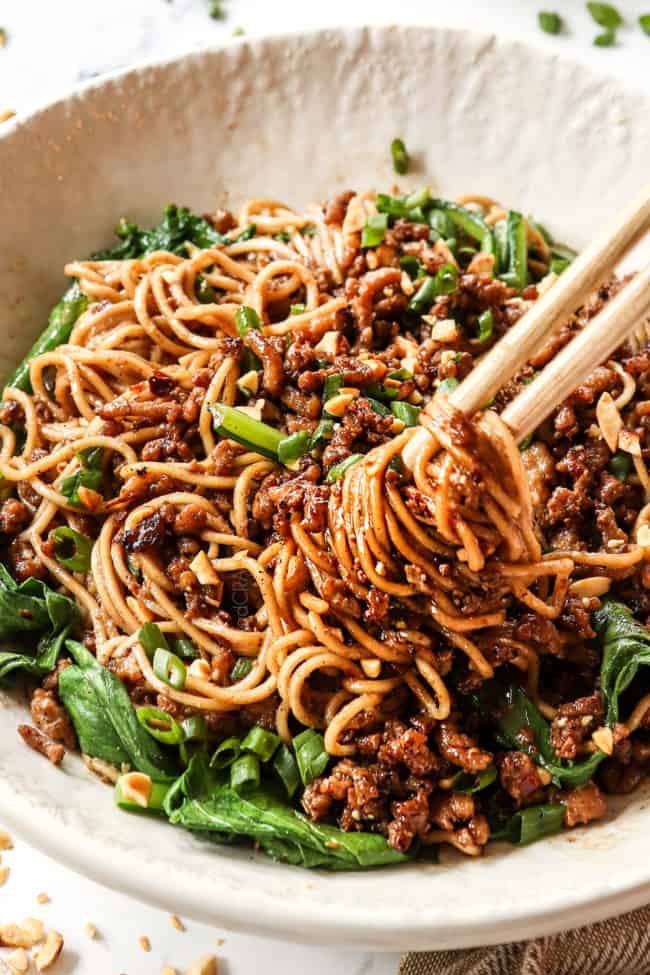
Want to try this Dan Dan Noodles RECIPE?
Pin it to your Asian, Noodles, Dinner or Chicken Board to SAVE for later!
Find me on Pinterest for more great recipes! I am always pinning :)!
©Carlsbad Cravings by CarlsbadCravings.com

Dan Dan Noodles (Dan Dan Mian)
Save This Recipe To Your Recipe Box
You can now create an account on our site and save your favorite recipes all in one place!
Ingredients
Chili Oil
- 1/4 cup vegetable oil
- 2 tablespoons toasted sesame oil
- 1 1/2 tablespoon red chili flakes
- 1/2 tsp EACH Sichuan peppercorn powder, Chinese five-spice powder
- 1 star anise optional
Dan Dan Sauce
- 1/3 cup reduced sodium chicken broth warmed
- 1/4 cup reduced sodium soy sauce
- 3 tablespoons Chinese sesame paste
- 1 1/2 tablespoons rice wine or dry sherry
- 1 tablespoon sugar
- 1 teaspoon Sichuan peppercorn powder
- 1/2 tsp EACH Chinese five spice powder, ground ginger
- 2 garlic cloves minced
- 3-4 tablespoons prepared chili oil in directions
Pork
- 1 tablespoon vegetable oil
- 8 ounces ground pork
- 2 teaspoons hoisin sauce
- 2 teaspoons rice wine or dry sherry
- 2 teaspoons dark soy sauce may sub regular
- 1/2 teaspoon Chinese five-spice powder
Sui Mi Ya Cai
- 1 teaspoon vegetable oil
- 1/2 cup sui mi ya cai see notes
Noodles and Greens
- 1 pound white fresh wheat noodles medium thickness
- 1 bunch choy sum chopped 6-inches from the top (discard the bottoms)
- green onions chopped
- peanuts, chopped (toasted in skillet, recommended)
Instructions
- Easy Chili Oil: Add all of the spices to a heat proof bowl; set aside. Add vegetable oil to a small saucepan and heat over medium heat for 2-3 minutes, until 325 degrees F (no hotter). Very carefully pour oil over the spices. Whisk in sesame oil; set aside. Start boiling the water for the noodles so it’s ready to cook them later.
- Sauce: Mix all Dan Dan Sauce ingredients together except chili oil until smooth then whisk in 2-4 tablespoons chili oil (see notes). Set sauce aside and reserve leftover chili oil.
- Pork: Heat oil in a skillet or wok over medium-high heat. Once very hot, add pork and cook and crumble. Once almost cooked through, add the rest of the pork ingredients and cook for 1-2 minutes until the liquid is absorbed/evaporated. If the pork isn’t crispy at this point, increase heat to high and cook another 1-2 minutes; transfer to a bowl.
- Sui Mi Ya Cai: Reduce heat to medium. Heat 2 teaspoons of oil in the now empty skillet. Add the sui mi ya cai and sauté for 60 seconds to warm through; set aside.
- Noodles and Greens: Cook the noodles according to package directions, adding the greens the last 30 seconds of cooking to blanch. Drain and toss noodles with a drizzle of sesame oil to prevent them from sticking together.
- Assemble: Divide the sauce among four bowls. Top with noodles, choy sum (or leafy greens), pork, green onions and peanuts. Mix everything together until the noodles are well coated in the sauce. Add additional chili sauce to taste if desired (taste first!).
Notes
Ingredient Notes and Substitutions
- Chili oil: Instead of homemade, you can also purchase Chinese chili oil at any Asian grocery store, just make sure to look for oil with actual red pepper flakes in it, I particularly like Blank Slate Kitchen Sichuan Chili Oil. Please note that Chinese chili oil is not the same as chili sauce or paste. If you are substituting with chili sauce, you will want to mix 1-part chili sauce to 2 parts oil.
- Chinese five spice powder: Is easy to find at most grocery stores or on Amazon. It is a combination of Szechuan peppercorns, ground cloves, fennel, cinnamon, star anise and cinnamon.
- Szechuan peppercorn powder: Adds peppery, numbing (not fiery) heat and complex citrus notes that is hard to replicate so please don’t skip it! I prefer Szechuan peppercorn powder because it is easy to use and save you a tedious step. Szechuan peppercorn can be found on Amazon at most Asian markets, spice stores, or sometimes specialty stores like Whole Foods and Sprouts.
- Chinese sesame paste (芝麻酱, zhi ma jiang): Is a thick paste made from roasted white sesame seeds. It thickens the sauce and adds a deep, nutty, smoky flavor. It can be found in Asian markets or on Amazon. Please note that Chinese sesame paste is NOT sesame sauce or tahini. The best substitute for Chinese sesame paste is peanut butter mixed with a few teaspoons of sesame oil.
- Rice wine: Can be found in the Asian aisle of the supermarket. Do NOT confuse rice wine with rice vinegar or rice wine vinegar. I use “Kikkoman Aji-Mirin: Sweet Cooking Rice Seasoning” which is commonly found in the Asian section of most grocery stores or you can Amazon it. The best substitute for rice wine is dry sherry.
- Hoisin sauce: Can be found in the Asian section of any grocery store. It tastes like a sweet, salty and tangy, thick Asian BBQ Sauce. Use high quality hoisin sauce like Lee Kum Kee because you literally can TASTE the difference!
- Fermented mustard greens (sui mi ya cai): are a type of cardamine bean sprout that is native to Sichuan, China that are dried, flavored with sugar and spices then fermented. They are a signature ingredient in Dan Dan Noodles and add an aromatic, slightly sweet, tangy, pungent, salty richness. If your Asian market carries them, they will be in small plastic packages near the pickled items, but they will not be refrigerated. However, sui mi ya cai can be difficult to find, even at an Asian grocery store, so I suggest ordering them on Amazon here. If you can’t find them Tianjin preserved vegetables, sold in squat jars at the Asian market, make a decent substitute or a mixture of kimchi and capers. If you don’t want to make a special trip to the market or order sui mi ya cai, you can skip them and your Chinese Noodles will still be tasty but they will be missing that complex layer of funk.
- Noodles: Dan Dan Noodles are usually made with round, medium thin wheat noodles, 1/8″ thick, not rice noodles. You can find semi-fresh wheat noodles in the refrigerated section at an Asian market, but they usually won’t be called out as Dan Dan Noodles. Instead, look for thin, white noodles and check the packaging to see if they’re made with wheat. If you can’t make it to the Asian market, any dry round, thin Asian wheat noodle will do, or substitute with linguine.
- Leafy greens: If you are making a trip to the Asian market, pick up a bunch choy sum. The stalks are quite long, so I tend to cut them in half and use the top half of the leafy stalk. Otherwise, choy sum can easily be substituted with a bunch of spinach or bok choy. To use bok choy, use the top 6 inches and slice the stalks so they’re no larger than ½-inch.
Tips and Tricks
- Customize heat: Dan Dan Noodles are meant to be spicy, but they don’t have to be fiery hot. I used 4 tablespoons chili oil and it was extremely spicy, but they were still incredible. 3 tablespoons chili oil will probably be the perfect amount for those who like very spicy, 2 tablespoons chili oil for those who like spicy but are little hesitant. It is probably wise to start off with less chili oil in the Dan Dan Sauce then let individuals add more chili sauce to their individual bowls.
- Don’t overheat oil: You don’t want to heat the oil any hotter than 325 degrees F or it will burn the spices upon contact. The homemade chili oil can be made ahead of time and stored in an airtight containers in the refrigerator for up to 6 months.
- Stir Chinese sesame paste: The oil will be separated from the thick paste underneath. You will need to stir the sesame paste thoroughly in the jar to incorporate the oil with the paste or you will only be getting thin oil and not the nutty richness. If the paste is full because it’s your first time using it, it may be easier to dump it all out into a larger bowl to stir instead of stirring in the jar.
- Toast peanuts: Toasting the peanuts enhances their nutty flavor and makes them 10X better – and it’s easy. To dry roast peanuts, add ½ cup unsalted raw peanuts to a skillet over medium-high heat without any oil and toast, stirring occasionally, until golden in spots.
- Vegetarian: To make Dan Dan noodles vegetarian, you may substitute the pork with minced mushrooms or firm tofu. To prep the tofu, place it in a pie plate, top with a heavy plate and weigh down with 2 heavy cans (to release water). Set aside for 10 minutes before chopping and stir frying.
- Low carb: To keep it low carb, try using shirataki noodles. Shirataki noodles are long, white noodles made from glucomannan, a type of fiber that comes from the root of the konjac plant. You can also use spiralized zucchini noodles.
How to Store and Reheat
- How to store: Store leftovers in an airtight container in the refrigerator for up to 5 days.
- How to reheat in the microwave: Transfer small portions to a microwave safe dish, heat for 1 minute, stir, then continue to heat at 20-second intervals as needed. You may need to toss the noodles with a drizzle of oil or chicken both to loosen the noodles.
- How to reheat on the stove: For larger portions, warm in a large skillet over medium-high heat, stirring often. You may need to toss with a drizzle of oil or chicken both to loosen the noodles.

Did You Make This Recipe?
Tag @CarlsbadCravings and Use #CarlsbadCravngs
Leave a Review, I Always Love Hearing From You!
Carlsbad Cravings© Original
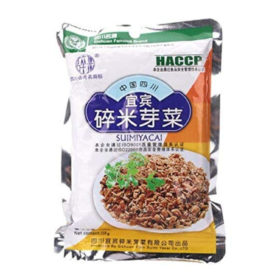
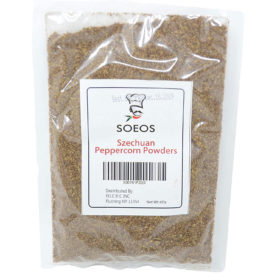
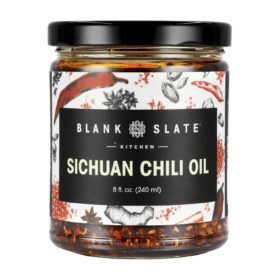
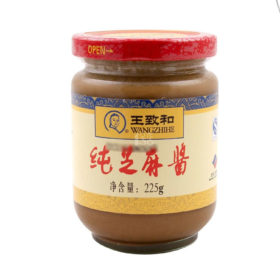


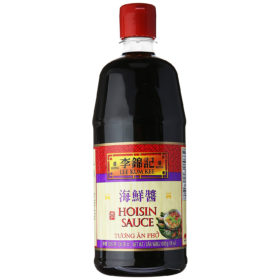
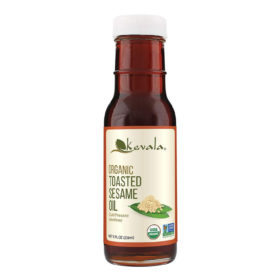
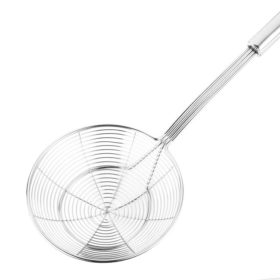
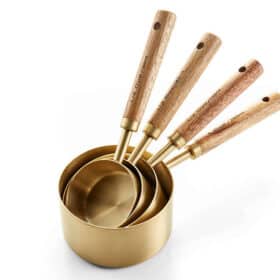
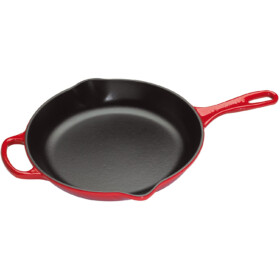

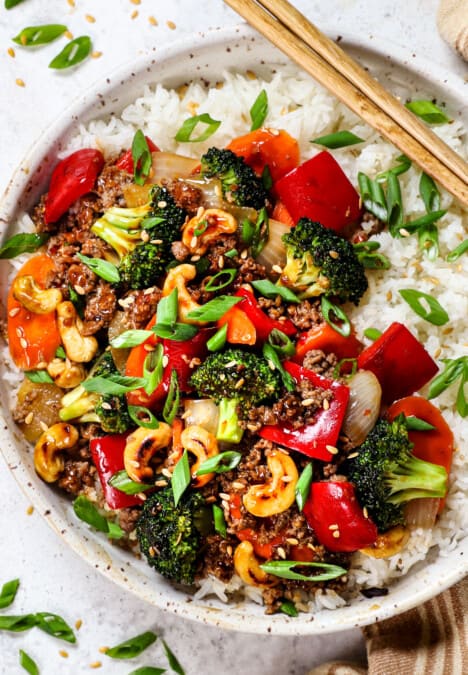


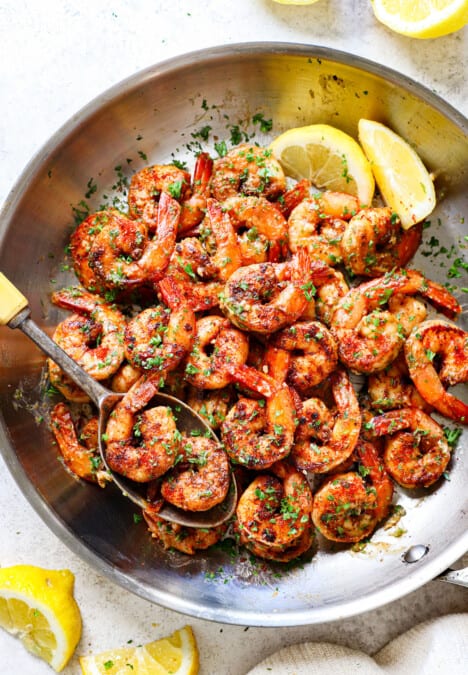
























Christopher Strauss says
I live in the middle of nowhere and the only thing I can find is wheat lo mein noodles. I think those are a little thicker than what you recommend, but would those work?
Jen says
Yes, those will absolutely work!
Christopher Strauss says
Thank you. BTW, during this pandemic I’ve made at least a hundred of your recipes. This is the best cooking blog website I’ve ever come across. I love Asian food and I’ve been able to find everything I need to make your recipes. (With some Amazon help). I think you’re unbelievably talented making all these great recipes accessible for those that live in the country and not near specialty grocery stores. For those of you reading this comment, try Jen’s panang curry. It really is better than anything I’ve had in any Thai restaurant.
Jen says
Thank you so much for your awesome comment Christopher! I am honored you are loving my blog and have made so many of my recipes! I love that you are an Asian recipe enthusiast and have really gone for it by purchasing the ingredient on Amazon/etc. Thanks again for for your kind words and making my day!
Mability says
I can’t wait to try this recipe. I love Dan Dan noodles and didn’t know what and how to get the ingredients and prepared them. You always provide a great explanation and resources on where to find the ingredients or what may be a good substitute. I enjoy your flavor profiles on every recipe too. Thanks so much for putting together this recipe and instructions. Can’t wait to get the ingredients and once I try it, I’ll update my comments.
THANK-YOU!
Jen says
Thank you so much for taking the time to comment – I’m excited you’re excited! I can’t to hear what you think!
Rachel says
I would like to try this but my husband has to be gluten free, would rice noodles work here?
I’ve had success adapting so many of your delicious recipes but I’m unsure about how this would turn out.
Jen says
Hi Rachel, yes, you can absolutely use rice noodles to make this gluten free!
Pamela Dent says
I made the Dan Dan noodles, and we loved them. I find your recipes very reliable. The only problem was a gritty texture, I think from the peppercorn powder. Is that normal?
Jen says
Thanks so much Pamela, I’m honored you find my recipes reliable, that is the ultimate compliment! The grittiness was probably from the Szechuan peppercorns. Did you grind the peppercorns yourself?
Kaaren Babb says
I am completely addicted to your recipes. They are so authentic, the flavor profiles are accurate, and most importantly, they work! For years I’ve been an Ina Garten devotee, and now, I’ve found her match: YOU! Thank your for your extensive explanations, and particularly, for insisting upon the best ingredients, just like I learned in Italy. Start with the BEST…… you are SO right. Kudos to you.
Jen says
Wow, I am honored and humbled to be compared to Ina, thank you so much Kaaren! I appreciate that you appreciate 😉 the thorough recipes and what it takes to make each recipe the best! Thanks for following along and for making my day! PS I just read your comment about Gelato Love-excited to check it out!
Jean says
Regarding the Dan Dan noodles recipe, initially rice vinegar was discussed to be used; however in the recipe rice wine was listed. Please clarify which should be used.
Jen says
Thanks for catching that! Rice wine should be used in both the sauce and the pork. Enjoy!